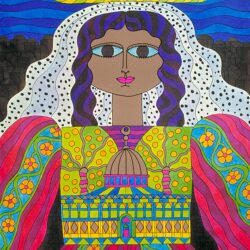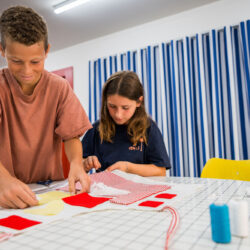Meet the 1970s and 1980s SOFT? artists

We are all specialists in the tactility of textiles without realising it. Our skin is in contact with fabrics all the time, whether it is our clothes or our bed linen. Textiles are a direct, universal, and intercultural form of communication. Moreover, just like food and shelter, textiles determine how we understand culture. Artworks made of textiles exert a distinct physical attraction. ‘SOFT? Tactile Dialogues’ focuses on the artistic and tactile power of these artworks, the turbulent history of the position of textiles within the fine arts canon, and the battle for recognition by artists who made this medium their own.

Anni Albers (Berlin, 1899–1994) was an influential figure in the art world with her abstract textile work. As a woman in 1922, she was unable to enroll in painting or sculpture courses at the radical and supposedly ‘egalitarian’ Bauhaus school because women were only allowed to study in the weaving department. The fact that textiles were not always a vocation or a first choice for women at art schools during this time is an observation that often gets lost in the footnotes of history. Indeed, it was not until the late nineteenth century that women were even allowed to attend art schools.

In the 1970s, as the women’s liberation movement picked up speed and the Vietnam War came to a bitter end, traditional crafts such as quilting, embroidery, macramé, dying, and knotting experienced a sudden revival. This resurgence was in line with the back-to-the-land and hippie movements, which resulted in a renewed interest in folk art and DIY clothing. It was within this context that textile art became prominent in the art world. Textiles suddenly became the preferred medium for many artists from various artistic backgrounds. Feminist, post-minimalist, and fiber artists all found their way into the world of textiles. They were attracted to the aesthetic possibilities, structural potential, and semiotic power of this ‘softer’ material.

Artists such as Sheila Hicks, Magdalena Abakanowicz, and Tapta used fibers and textiles to create monumental, non-woven, and threedimensional works. In Europe, these artists were stimulated by the Tapestry Biennials in Lausanne. From 1967 onwards, these biennials broke with traditional weaving and evolved towards experimental ‘free weaving’ and textile arts. Later in 1969, the MoMA organised the first major exhibition entitled ‘Wall Hangings’ in New York City, which accordingly introduced the world to the ‘new’ medium.

In the 1970s, heated debates about whether fiber art was ‘art’, ‘applied art’, or a ‘craft’ were prevalent. Art critics were strongly influenced by the association of textile art with ‘femininity’ and ‘domesticity’, therefore undermining the artist’s credibility simply because of their gender. This judgement seems absurd considering that male artists were also using textiles in their works. Take the many felt sculptures by Robert Morris or Joseph Beuys, for example, which were never judged in terms of gender or the character of the materials. Textiles were not the only new medium to emerge at this time: new, industrial materials were being used in minimalist sculpture, and there was a development of performance, video, installation, and activist art. These ‘new media’ collectively blurred the boundaries between ‘art’ and ‘the everyday’, and between the ‘fine’ and the ‘applied’ arts. Although some fiber artists had particularly successful careers, the widespread use of textiles in daily life meant that the medium was marginalised in the hierarchy of the arts.

Textiles loaded with gender prejudices were not a new revelation. In the nineteenth century, women who wanted to be taken seriously in a patriarchal society felt that it was necessary to distance themselves from handicrafts. For example, Charlotte Brontë’s twelve-year-old heroine in Shirley (1849) complains that embroidery limits the intellectual life of women. Brontë’s character equated the boring monotony of handicrafts with a living death. Feminists in the nineteenth century kept their distance from the ‘feminine ideal’ of embroidery; at the beginning of the twentieth century, that became exactly the weapon suffragettes deployed as they marched through the streets with embroidered banners demanding women’s right to vote. Due to the Victorian association of embroidery with chaste femininity, suffragettes used it to make rather ‘unfeminine’ demands.

Like the suffragettes, feminist artists in the 1970s like Judy Chicago and Miriam Schapiro used textiles and embroidery to take on power relationships in the art world. They used textiles and handiwork with militant intent to break down the outdated hierarchy between art and craft. A remarkable movement in textile art also emerged in Belgium in the 1970s. The artists from this movement belonged to the so-called ‘Textielgroep’, who were supported with group exhibitions and lectures organised by Jan Walgrave, the curator of the Provincial Museums of Antwerp at the time. Belgian artists such as Liberta Ferket, Tapta, Marga, and Lieva Bostoen brought their monumental woven sculptures and installations into dialogue with the viewer and the space.
At that time, we as a group of textile artists with very diverse working methods showed monumental works at exhibitions. Textiles took on different values, adopting sculptural and architectonic forms that we used to make a clear statement.
In an intimate setting, ‘SOFT?’ presents a selection of the works Jan Walgrave added to the Vrieselhof collection in the 1970s that formed a special subset of the MoMu collection today. The Belgian artists featured in this collection worked with a wide range of materials. One can smell the old tarry ropes from the harbour boats in Veerle Dupont’s monumental work ‘Alruin’. In Edith Van Driessche’s ‘Use No Hooks’, recycled fabrics tell a new story. The works are often autobiographical too: Hetty Van Boekhout’s appliqué embroidery with its stuffed figures, and Kaye Regelski (Spilker)’s assemblages of personal letters. Suzannah Olieux expresses social criticism in her symbolic batik compositions.
In that period, Jan Walgrave and the Textielgroep managed to create a sense that the medium was an exciting art form with unexplored potential and even more surprising forms of expression. But there were undoubtedly prejudices in the 1970s and 80s as well.
Because textiles were associated with ‘domestic work’ and most of the artists in the Textielgroep were women, it would also prove difficult to establish themselves in an art world predominantly run by men. Many of them later moved into different media partly as a result.
The question mark in ‘SOFT?’ symbolises the various questions and prejudices that the subject of textile art evokes. Beneath the soft surface, textiles often engage with politics and society. The textile artists of this first generation very often found themselves in the margins of the art world. Nonetheless, their persistent efforts were crucial to the acceptance and emancipation of textiles as an accepted medium within contemporary art. From international art biennales and art fairs, to art school graduation shows, we can no longer imagine the art world without textiles.

For the very first time, MoMu is exhibiting the works of this first generation in dialogue with contemporary artists including Kati Heck, Nel Aerts, Anton Cotteleer, Sven ’t Jolle, Klaas Rommelaere, Ermias Kifleyesus, Christoph Hefti, Stéphanie Baechler, Jelle Spruyt, Wiesi Will, Gommaar Gilliams, and Kirstin Arndt. This younger generation expresses themselves in textiles without inhibitions and does so in combination with other media. They owe this freedom to the first generation’s pursuit and the changed perception within art criticism that the quality of an artist’s work has little to do with their style or medium and all to do with their artistic intention. The fluidity of the concepts concerning ‘gender’ and ‘identity’ today have doubtlessly contributed to the exponential increase in textiles within contemporary art. The gradual departure from gender pigeonholing and dogmatic stereotypes is a development in both society and the arts that needs to be cherished. ‘SOFT? Tactile Dialogues’ is about the freedom of artists to move between different media, about unexpected applications of textiles, about tactility and aversion, and about texture and the skin of sculptures.



